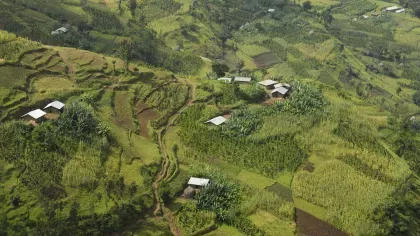Modelling and genomics resources to enhance exploitation of the sustainable and diverse Ethiopian starch crop Enset and support livelihoods
Towards developing a resilient Ethiopian crop into a key resource for the future in both its home country and the rest of Africa.

Introduction
Enset is a large perennial herbaceous plant similar in form to the related banana. It is encountered as a wild plant across central, eastern and southern Africa. However, it has only been domesticated in Ethiopia, where it currently provides a food source for ~20 million people via its corm and stem base supplying dietary starch.
Little is currently known about Enset’s biology, including its physical traits and genetic variation, and the pollination and dispersal of both its wild and cultivated forms, its fruiting and seed biology, or ability to withstand pests and diseases.
We aim to develop the biodiversity science information resources needed and fill critical knowledge gaps and simultaneously build collaborative UK/African research strengths. This will enable the exploitation of enset diversity as a resilient climate-smart crop of the future.
The importance of Enset
Enset has a number of important attributes as a crop. Perhaps the most significant is its potential to be a climate-smart crop for the future because of its apparent ability to withstand long periods of drought (>5 years). The plant can be harvested at any time during the year and at any stage over several years. Enset-derived starchy foods can also be stored for long periods. The carrying capacity of land planted to enset is ca 0.2 hectares for a household of seven people, as opposed to 1.5 hectares of land with annual grain; yield from enset therefore has the ability to support a larger population per unit area than regions that grow cereals. Enset also supplies fibres, medicines, animal fodder and a food source for bees. It stabilises soils and microclimates and is culturally significant. As a result of these qualities, enset farming provides a long-term, sustainable food supply, with minimum off-farm input.
The planned research
Our research will fill a critical knowledge gap on enset, a drought-resilient crop that is important for food security and nutrition especially during times of water scarcity. This project aims to provide information that will ensure availability of enset now and in the future via the objectives and work packages below.
Enset and the SDGs
The project seeks to progress UN SDG2 (End hunger, achieve food security and improved nutrition and promote sustainable agriculture) and SDG15 (Use terrestrial ecosystems sustainably/halt biodiversity loss) and to contribute to SDG1 (End poverty), SDG3 (Ensure healthy lives) and SDG13 (Combat climate change).
Kew’s role in the project
Kew is responsible for objectives and work packages 1, 2 and 4 below in collaboration with Addis Ababa University and other Ethiopian partner organisations. It also leads the project.
Objectives
- Gathering a range of data from across the distribution of Enset in Ethiopia including its physical traits alongside information about the local climate and soil in each area sampled and data from farmer interviews. This will be used to create a data resource via computer models that will generate phenotypic resources to underpin breeding, food security and supply of products and enhanced government policy in this crop.
- Studying enset in the field so that its flowering, fruiting and seed production are fully understood to assist in developing a breeding programme and conserving the species through its seeds. Farmers harvest the crop before inflorescencess are initiated, thus they are rarely seen.
- Unravelling the genome of the banana family, and especially enset, to understand overall diversity patterns and discovering the genes associated with desirable characteristics such as control of flowering, disease resistance and root and corm development.
- Surveying the occurrence of disease-causing organisms in the field to discover non-susceptible populations and varieties for genetic study and conservation at in-country seed banks and living plant collections with those displaying other useful traits.
In order to meet the objectives described above, research will be undertaken in four interrelated work packages:
- Developing a multi-dimensional, multifunctional, baseline resource for enset cultivation.
- Confirming the flowering and fruiting biology of enset and its propagation.
- Realising the potential of the genetic diversity of cultivated and wild enset.
- Determining the resilience of enset to pests and pathogens.
- A multi-dimensional, multifunctional, baseline resource for present and future enset cultivation in Ethiopia.
- Seven publications on Enset diversity, pollination, seed biology, agroecology, genomics and disease incidence.
- Low-cost tissue culture protocols for disease-free, resilient selected varieties of enset in partnership with local cooperatives; disease diagnostic tools using sequence data from the genetic diversity and pest and pathogen resilience work packages.
- Enhanced germplasm and seed conservation collections.
- A cross-ministry national strategy for enset in Ethiopia.
University of Leicester
- Prof. Pat Heslop-Harrison
- Dr. Trude Schwarzacher
- Dr. Mark Goodwin
Addis Ababa University
- Prof. Sebsebe Demissew
BBSRC via Global Challenges Research Fund Foundation Award
Projects
Research Councils UK, Gateway to Research
Kew Science Projects
Yams of West and South West Ethiopia
Resources
Plant Resources of Tropical Africa
Global Musa Genomics Consortium
